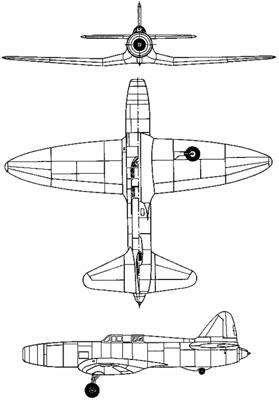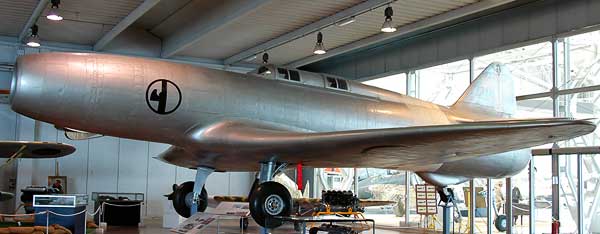Caproni Campini N.1
The Campini - Caproni CC2 ( often referred to as " Campini - Caproni N.1 ") is a luftansaugendes, thermojetgetriebenes aircraft, which was built in Italy. The first flight was on 27 August 1940. The CC2 was the second jet-powered aircraft in the world.
History
Prehistory
Although Italy was not one of the leading countries in the field of air jet propulsion, it was with the Caproni Campini CC.2 the second country in which flying such an aircraft. However, this was in truth no more than a stroke of genius, in which a conventional piston engine was used to drive a ducted propeller as a compressor with adjustable blades and imperfect combustion. As such, this drive did not contribute to the gas turbine research, but led to an impasse. The engineer Secondo Campini in 1931 founded a company, to conduct research in the field of jet propulsion.
Formation
Ing Secondo Campini convinced in the year to build an aircraft Count Gianni Caproni in 1939 in order to test the fruits of his labor, namely the adaptation of a V- twelve-cylinder aircraft engine Isotta Fraschini Asso - L.121 RC.40 with 912 hp ( 671 kW ) to the drive of a three-stage axial compressor casing, wherein the compressed air is ejected through a nozzle having a variable cross -section in the rearmost part of the rear plane and additional fuel has been ignited in the jet pipe, in order to increase the thrust. Thus, the CC2 was the first jet-powered aircraft, which had a nozzle with variable cross-section.
First flight
This two-seater machine CC2 with the serial number MM487 was flown for the first time on August 27, 1940 by Mario de Bernardi Taliedo for about 10 minutes. On 16 September of the same year, the first prototype was flown again for 5 minutes.
Further testing of
A number of previously carefully planned demonstration flights performed, including a more than 270 km from Taliedo after Guidonia Monte Celio in Rome with an average speed of 209 km / h The second prototype ( MM488 ) flew on 30 April 1941 its first official flight took place on 30 November 1941, when Mario De Bernardi and the engineer Giovanni Pedace flew in the rear pulpit from Milano Linate Airport to Guidonia while 475 km at an average speed of 217 km / h laid back. A third copy was completed without a machine.
Reactions
The company Caproni Campini and proved to be terrific success for the fascist regime of Italy, the massively promoted the aviation without regard to cost. Italy received a total of 33 congratulatory telegrams from abroad and the International Air Transport Association FAI homologated the CC2 as the first jet-powered aircraft in the world - because until then the aviation world had no knowledge of the secret experiments of Hans von Ohain and Heinkel about a year earlier in German Reich, as these on 27 August 1939 the Heinkel He 178 could fly for the first time.
Termination of the experiment
From the outset it was clear that the use of a three-stage compressor casing, which was powered by a piston engine would restrict further development. The experiment was therefore abandoned in early 1942, but mainly due to the unexpectedly low speed.
Whereabouts
The first prototype was probably destroyed in 1943. The remains were brought to England in October 1944 to the Royal Aircraft Establishment Farnborough and scrapped after multiple stops in 1949. The second prototype was preserved and is now in the Italian Aviation Museum at Vigna di Valle Rome issued. The airframe of the third copy is now in the possession of the Museum of Science and Technology in Milan.
Specifications
Comparable types
Engine jet engine
- Coanda -1910
Turbojet engine
- Heinkel He 178 - the first jet aircraft worldwide from Germany
- Gloster E.28/39 - the first British jet aircraft
- P -59 Airacomet - first American jet plane







.jpg)


